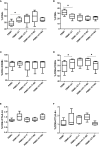Interaction between peripheral blood mononuclear cells and Trypanosoma cruzi-infected adipocytes: implications for treatment failure and induction of immunomodulatory mechanisms in adipose tissue
- PMID: 38533504
- PMCID: PMC10963431
- DOI: 10.3389/fimmu.2024.1280877
Interaction between peripheral blood mononuclear cells and Trypanosoma cruzi-infected adipocytes: implications for treatment failure and induction of immunomodulatory mechanisms in adipose tissue
Abstract
Background/introduction: Adipose tissue (AT) has been highlighted as a promising reservoir of infection for viruses, bacteria and parasites. Among them is Trypanosoma cruzi, which causes Chagas disease. The recommended treatment for the disease in Brazil is Benznidazole (BZ). However, its efficacy may vary according to the stage of the disease, geographical origin, age, immune background of the host and sensitivity of the strains to the drug. In this context, AT may act as an ally for the parasite survival and persistence in the host and a barrier for BZ action. Therefore, we investigated the immunomodulation of T. cruzi-infected human AT in the presence of peripheral blood mononuclear cells (PBMC) where BZ treatment was added.
Methods: We performed indirect cultivation between T. cruzi-infected adipocytes, PBMC and the addition of BZ. After 72h of treatment, the supernatant was collected for cytokine, chemokine and adipokine assay. Infected adipocytes were removed to quantify T. cruzi DNA, and PBMC were removed for immunophenotyping.
Results: Our findings showed elevated secretion of interleukin (IL)-6, IL-2 and monocyte chemoattractant protein-1 (MCP-1/CCL2) in the AT+PBMC condition compared to the other controls. In contrast, there was a decrease in tumor necrosis factor (TNF) and IL-8/CXCL-8 in the groups with AT. We also found high adipsin secretion in PBMC+AT+T compared to the treated condition (PBMC+AT+T+BZ). Likewise, the expression of CD80+ and HLA-DR+ in CD14+ cells decreased in the presence of T. cruzi.
Discussion: Thus, our findings indicate that AT promotes up-regulation of inflammatory products such as IL-6, IL-2, and MCP-1/CCL2. However, adipogenic inducers may have triggered the downregulation of TNF and IL-8/CXCL8 through the peroxisome proliferator agonist gamma (PPAR-g) or receptor expression. On the other hand, the administration of BZ only managed to reduce inflammation in the microenvironment by decreasing adipsin in the infected culture conditions. Therefore, given the findings, we can see that AT is an ally of the parasite in evading the host's immune response and the pharmacological action of BZ.
Keywords: Trypanosoma cruzi; adipokine; adipose tissue; benznidazole; chemokine; cytokine; immunomodulation.
Copyright © 2024 Moreira, Silva, Costa-Oliveira, Silva-Júnior, Oliveira, Torres, Barros, Rabello and de Lorena.
Conflict of interest statement
The authors declare that the research was conducted in the absence of any commercial or financial relationships that could be construed as a potential conflict of interest.
Figures









Similar articles
-
Adipose Tissue in Chagas Disease: A Neglected Component of Pathogenesis.Pathogens. 2025 Mar 31;14(4):339. doi: 10.3390/pathogens14040339. Pathogens. 2025. PMID: 40333112 Free PMC article. Review.
-
Benznidazole treatment decreases IL-6 levels in Trypanosoma cruzi-infected human adipocytes differentiated from adipose tissue-derived stem cells.Mem Inst Oswaldo Cruz. 2023 Oct 23;118:e220295. doi: 10.1590/0074-02760220295. eCollection 2023. Mem Inst Oswaldo Cruz. 2023. PMID: 37878830 Free PMC article.
-
Dynamics of the Trypanosoma cruzi infection in adipose tissue: Assessing gene expression of PNPLA2, FASN, and ACAT1 under Benzonidazole treatment and indirect mononuclear immune cells interaction.Mol Biochem Parasitol. 2024 Jun;258:111618. doi: 10.1016/j.molbiopara.2024.111618. Epub 2024 Apr 6. Mol Biochem Parasitol. 2024. PMID: 38588892
-
Benzonidazole treatment has a beneficial effect on cells infected with the Colombian strain of Trypanosoma cruzi.Parasite Immunol. 2023 Jun;45(6):e12983. doi: 10.1111/pim.12983. Epub 2023 Apr 17. Parasite Immunol. 2023. PMID: 37066749
-
Modulation of Trypanosoma cruzi-specific T-cell responses after chemotherapy for chronic Chagas disease.Mem Inst Oswaldo Cruz. 2015 May;110(3):414-21. doi: 10.1590/0074-02760140386. Mem Inst Oswaldo Cruz. 2015. PMID: 25993507 Free PMC article. Review.
Cited by
-
Adipose Tissue in Chagas Disease: A Neglected Component of Pathogenesis.Pathogens. 2025 Mar 31;14(4):339. doi: 10.3390/pathogens14040339. Pathogens. 2025. PMID: 40333112 Free PMC article. Review.
-
Vitamin D treatment distinctly modulates cytokine production by peripheral blood mononuclear cells among patients with chronic cardiac and indeterminate clinical forms of Chagas disease.Immun Inflamm Dis. 2024 Sep;12(9):e1330. doi: 10.1002/iid3.1330. Immun Inflamm Dis. 2024. PMID: 39267468 Free PMC article.
References
-
- World Health Organization . World Chagas Disease Day 2022 - Finding and reporting every case to defeat Chagas disease (2022). Available online at: https://www.who.int/news-room/events/detail/2022/04/14/default-calendar/... (Accessed November 18, 2023).
Publication types
MeSH terms
Substances
LinkOut - more resources
Full Text Sources
Medical
Research Materials
Miscellaneous

